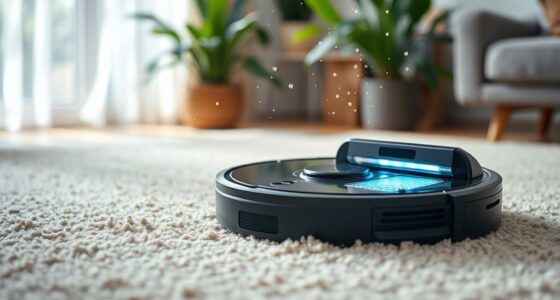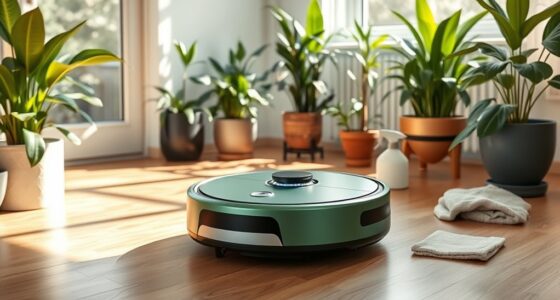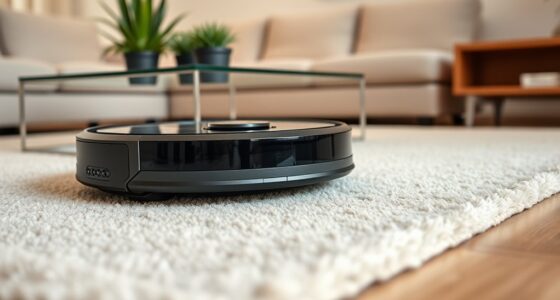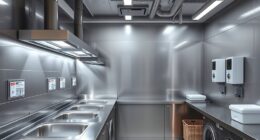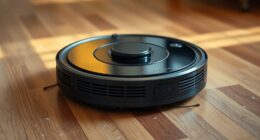If you’re comparing low-profile robots to standard models for cleaning under furniture, you’ll find that low-profile robots excel due to their slim, compact design, allowing them to slide easily beneath beds, sofas, and cabinets. They often feature advanced navigation tech like lidar or cameras, helping them efficiently map rooms and target dust-prone areas. This means better access and thorough cleaning in tight spaces. To discover specific features and tips for choosing the right robot for your home, keep exploring further.
Key Takeaways
- Low-profile robots can easily slide under furniture like beds and sofas, reaching areas standard models cannot access.
- Advanced navigation tech in low-profile robots ensures thorough cleaning beneath furniture, reducing dust buildup.
- Standard robots are often too tall to access tight spaces, leaving dust and debris untouched in hard-to-reach spots.
- Low-profile designs improve cleaning efficiency in confined areas, promoting a healthier home environment by removing hidden dust.
- Choosing a low-profile robot enhances overall cleaning by effectively reaching under furniture and minimizing manual cleaning efforts.

Have you ever wondered why dust and dirt tend to accumulate under your furniture? It’s a common problem that can be frustrating to deal with, especially since cleaning those hard-to-reach spots often feels like a chore. When you’re trying to keep your home spotless, understanding how different cleaning tools handle dust accumulation can make a big difference. One key factor is the type of robot you use—specifically, whether it’s a low-profile robot or a standard-sized model. Your choice impacts how effectively you can clean beneath furniture and how well the robot navigates tight spaces.
Low-profile robots are designed with a slim, compact body that easily slides under beds, sofas, and cabinets. Because of their low height, they can reach areas that standard robots often can’t, which means you spend less time manually cleaning those tricky spots. This design also allows for better dust removal since the robot can access the edges and corners where dust tends to settle and accumulate. The robot’s ability to navigate efficiently in tight spaces depends heavily on its sensors and navigation system. Many low-profile models feature advanced robot navigation technology, such as lidar or cameras, that map out your room and plan *ideal* cleaning routes. This ensures that every inch under furniture gets cleaned thoroughly, reducing dust accumulation over time. Additionally, dust particles are especially likely to settle in those hard-to-reach areas, making effective cleaning vital for a healthier home environment.
In contrast, standard robots are often taller and have a broader cleaning head, which makes them less adept at fitting underneath furniture. While they may cover larger areas more quickly in open spaces, they struggle in confined spots, leaving dust and dirt untouched. This means dust accumulation can persist in those hidden areas, especially if your furniture is low or has a skirt that drags on the floor. If your main goal is to keep dust from building up under furniture, a standard robot might not be the best choice unless you’re willing to move furniture frequently or supplement with manual cleaning.
The difference in how these robots handle dust accumulation comes down to their design and navigation. Low-profile robots excel at reaching those dust-prone spots, thanks to their ability to slide under furniture and their precise navigation. Proper robot navigation ensures that they can identify the best cleaning paths, avoid obstacles, and cover every inch of your floor. This results in less dust buildup over time and a cleaner, healthier home environment. So, if you want to minimize dust and keep those hidden areas spotless, investing in a low-profile robot with advanced navigation features is a smart move. It’s all about choosing a device that adapts to your space and keeps your home free of dust in those hard-to-reach corners.
Frequently Asked Questions
How Do Low-Profile Robots Compare in Battery Life?
When considering battery life, you might wonder how low-profile robots compare. Generally, they have slightly shorter power longevity than standard models because their compact design can limit battery size, affecting battery efficiency. However, many low-profile robots optimize power consumption well, helping to extend their runtime. So, while they may not last as long per charge, their efficiency guarantees they still effectively clean under furniture without frequent recharging.
Can Standard Robots Clean Under Very Low Furniture?
Standard robots often struggle to clean under very low furniture due to design limitations, like taller bodies that can’t fit into tight spaces. While they excel in open areas, their cleaning effectiveness drops in hard-to-reach spots. You might find that low-profile robots are better suited for these tasks, as their slim design allows them to slide underneath furniture easily, ensuring more thorough cleaning where standard models can’t reach.
Are Low-Profile Robots More Expensive Than Standard Models?
Did you know low-profile robots can be up to 30% more expensive than standard models? You’ll find that the price comparison reveals these robots often cost more due to their specialized design. The feature differences include enhanced agility and ability to reach tight spaces, which adds to the cost. So, if you need a robot that cleans under low furniture, be prepared for a higher price tag compared to standard models.
How Easy Is It to Switch Between Different Robot Types?
Switching between different robot types is usually straightforward, especially if they share a similar user interface design. You can quickly manage robot maintenance routines and navigate settings without hassle. Most models allow app-based control, making it easy to switch modes or functions. However, some low-profile robots might have unique features requiring a bit of learning curve, but overall, user-friendly interfaces make shifting smooth and hassle-free.
Do Both Types Handle Obstacles Under Furniture Equally Well?
Both low-profile robots and standard models handle obstacle navigation under furniture differently. Low-profile robots excel at maneuvering under furniture with lower heights because of their reduced furniture height clearance. Standard robots may struggle with obstacles hidden beneath low furniture, leading to missed spots or getting stuck. For effective cleaning under furniture, your choice depends on furniture height—low-profile models are generally better for tight spaces, ensuring thorough coverage.
Conclusion
When choosing between low-profile robots and standard ones for cleaning under furniture, think of it like selecting the right tool for a tight spot. Low-profile robots slip effortlessly beneath furniture, tackling dust bunnies like a swift breeze. Standard robots might struggle or miss those hidden corners. Ultimately, your choice depends on how much you value convenience and thoroughness. Picking the right robot is like finding the perfect fit—making your cleaning routine smoother and more efficient.


